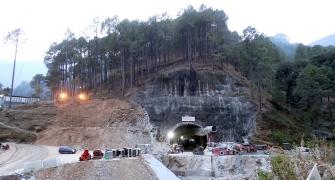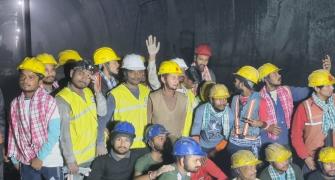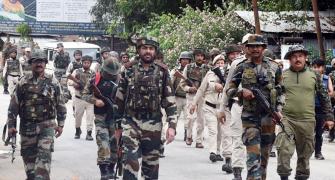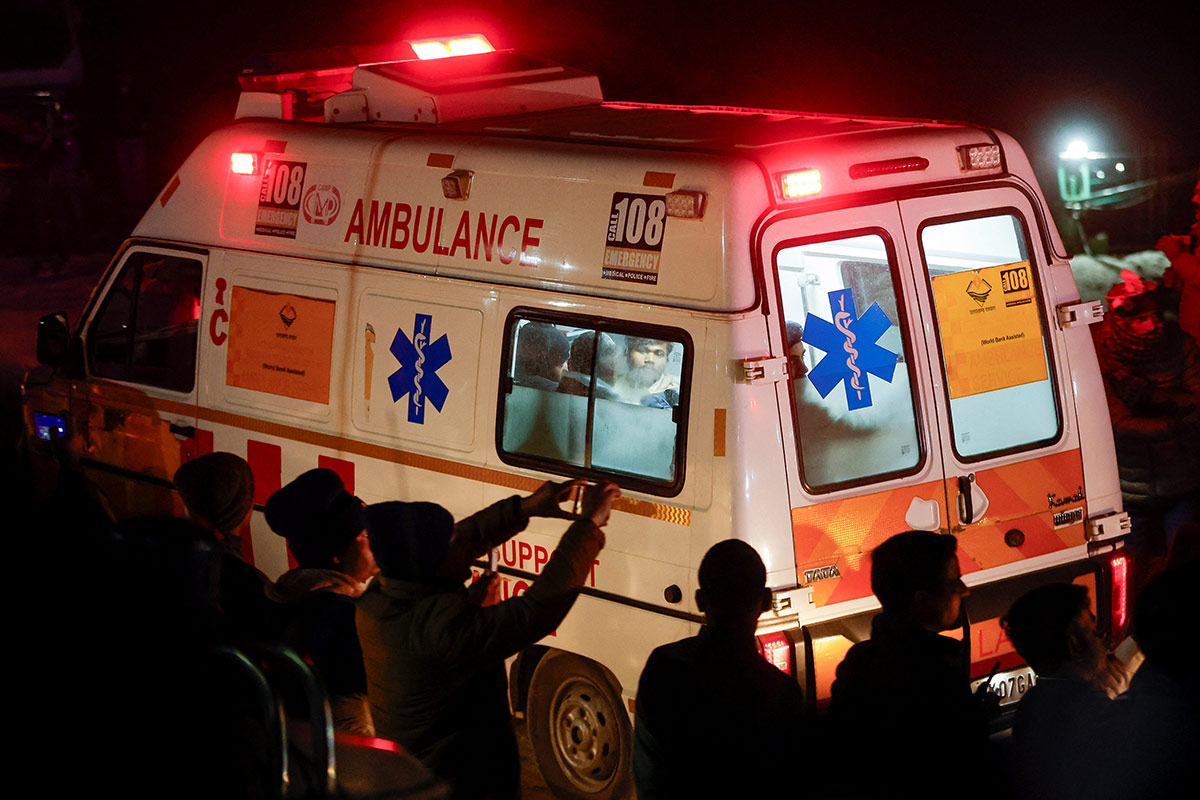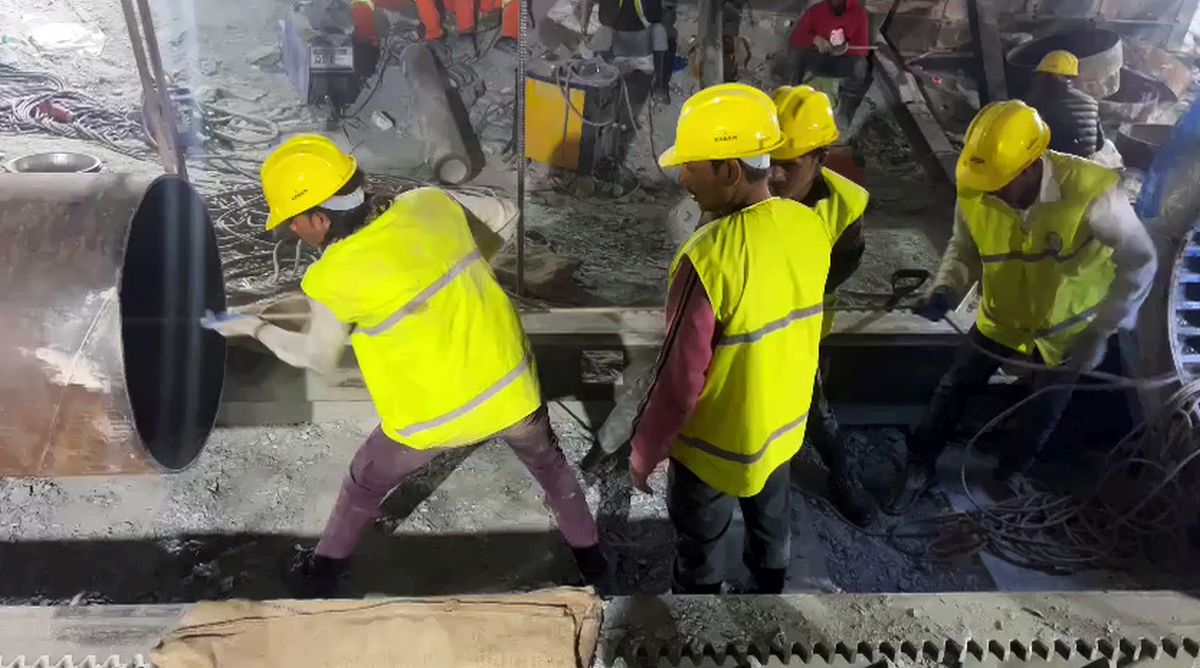'I decided to send a bat and a ball which was smaller in size so that it shouldn't get stuck in the pipe. And with that, they had a little good time.'

Colonel Dipak Patil, who was in charge of the incredible and successful 17-day long, hair-raising rescue operations at the Silkyara tunnel, gives Prasanna D Zore/Rediff.com the minute-by-hair-raising-minute account of how the arduous rescue operation unfolded, the challenges faced during this unending ordeal, the determined effort put in by each and every member of several organisations that were part of this mission and also answers a lot of experts' criticism that adequate safety protocols were violated during the construction of the ill-fated tunnel.
Colonel Patil, the former general manager of the National Highways Infrastructure Development Corporation Limited, who was repatriated to the Indian Army after a five year and two month stint at the NHIDCL, has been reassigned to the NHIDCL again.
With an extension of a year at the NHIDCL, Colonel Patil now wishes to complete the project before joining the Corps of Engineers of the Indian Army to which he belongs.
"I wish to complete this challenging project. It is one of the most difficult projects in the Himalayas because of the large diameter of the tunnel and because of the fragile geology through which it is going," the colonel says.
"I'll stay with them (the NHIDCL) for another year and continue to offer my duties and my expertise in this field. I will continue to perform," he adds.
The first of a two-part interview:
How did you become part of the rescue effort at the collapsed Silkyara tunnel?
I was on deputation from the Indian Army as a general manager at NHIDCL. I belong to the In army's Corps of Engineers. Army Headquarters called me early morning at 5.30 on November 13 that they have decided to send me to assist in the rescue operation at Silkyara tunnel.
I told them I was willing to go because these are my people, I have worked with them for quite some time and it is also my responsibility to help in their rescue.
I was dropped by an army helicopter near the rescue site. As soon as I was airdropped I started helping in the rescue effort.
Senior NHIDCL officials were already present at the site and rescue efforts were already on. I substantiated by adding my experience of the terrain.
What were your first impressions when you landed at the spot? What did you think about the challenges that you could face in the days ahead?
Whenever there's a collapse of this nature, the first thing you need to do is actually seal the rock creeps in the area and use rock bolts to ensure that no further cavity-formation takes place. That is the basics.
But at this site, people had already put up an Auger rig, which was very old and dilapidated. They could mobilise it from somewhere and they had already started doing the Augering. Finally, the machine gave away. It could not further push in the 900mm diameter pipe and we had to abandon it and replace it with a new one.
The new Auger drill was flown in using an Indian Air Force C-130 Hercules. We used three of these aircraft and one Mi-17 aircraft to land at ALG (Advanced Landing Ground) at Chinyalisour-Dharasu. Once those machines landed, we got it out from the C-130 and placed it inside the tunnel near the debris and started the Augering system.
We could have also resorted to a system called side drifting -- in side drifting we make a small little tunnel using the existing right hand side wall and we could have gone through it (to the place where the 41 workers were trapped). That could have taken a little more time, yes, of course, but that was also one method. We would have done used-pipe roofing umbrella (method) to help us in moving forward into the debris.

However, the Auger also was an okay kind of idea and it worked. We could punch in to about 47 metres with little hurdles; may be at one or two odd places we got some boulders which the Auger's head could break easily, with the help of the drill bit which was placed in front of the Auger.
And then at 47.7 metres we actually got stalled where a lot of steel reinforcements in terms of lattice girders, in terms of the forepoling pipes (a system used to support weak roofs), 42mm diameter pipes, they all got entangled into the Auger's drill head, and then we could not pull it back.
So, then we started using additional power to pull it back and then the Auger started breaking at the weak zones and most of it got stuck inside.
This Auger, when it got stuck inside, there's no other way but to send manpower inside and cut it into small chunks of metre each, two metres each. They are quite heavy, so it was not even easy to move them, pull them out using manpower.
Once all these Augers were out, we started using manpower to go inside, clear the debris in front of the pipe, and cut those steel girders and steel pipes coming in front of the pipe. The pipe was also bent for about one-and-a-half metres, and we removed that deformed pipe head.
Now, we again started pushing manually using labourers, who are experts, to go inside the small constricted space to start removing the muck from right next to the 900mm diameter pipe. Now it was telescoped with the 800 diameter pipe to reduce friction.
This is how we went inside and reached the men for the next 13-odd metres using the manual method.
We could then get them out using the NDRF, SDRF people who were actually trained for this. There was also the army on the standby. Navayuga (Enterprises, which has the contract to build the Silkyara tunnel) people were there.
There were also a lot of engineers who were helping using the Auger machine to push the pipes inside, plus there were a lot of officials from everywhere -- senior NHIDCL officials, from the ministry of road transport and Highways, from the government of Uttarakhand, from ONGC, from Border Roads (Organisation), from Satluj Jal Vidyut Nigam.
There were multiple plans which were made, and in parallel, we started executing two more plans (of constructing two horizontal tunnels parallel to the existing tunnel and drilling a pipe from the top of the hill).
Could you, in brief, take us through the ups and downs that the entire rescue team faced over these 16-17 days beginning November 12-13?
It was a long drawn operation. We had to keep our patience. We had to ensure that we don't stop the work anywhere. We keep removing the hurdles, which we were facing time and again, moment-after-moment; like, we were going two metres ahead and we were coming back one-and-a- half metre.
We had to cut that pipe, which was deformed and damaged, so the setbacks were there. But then we could not lose hope. We had to succeed and we had to get our men back.

You must have also been communicating with the trapped workers inside the tunnel. What was their state of mind?
It seems that to keep themselves mentally and physically fit these trapped workers also played cricket inside the tunnel?
That was my idea. I had sent the cricket ball and the bat which was a little smaller in size.
Initially, we were communicating with them using a 100mm diameter pipe. That was a water pipe, actually. We had opened it up from both sides, and we used to send food and then seal it up and then use the compressor's air to throw the food in.
Then they used to collect that food, which was basically kurmura (dry puffed rice) and chana (gram) and all that stuff, which was light in weight and these (food items) were less likely to get stuck somewhere because that lifeline was very important.
That was the only way by which we were talking to them, sending food to them and also send compressed air to them.
Later on I was able to punch in a 150 mm-diameter pipe. They had tried almost two, three times, but the third time I said, no, now this time I'll stand here and I'll ensure that you put it in the correct degrees and the correct method and then we succeeded in that.
When that pipe went in, through it we could send a lot of hard food, a lot of khichdi, rotis, chapattis, subjis, dry fruits, fruits, bananas, apples, everything.
We were actually putting into bottles, plastic bottles, and tying it up on a rope. And these bottles, because they have a rounded shape near the cap, it could not get stuck anywhere. It could easily move into the pipe to and fro.
This way they had enough food stored for the next 15-odd days.
Could you recount any interesting conversations you've had with the trapped workers?
One time they asked me, sahab, can you send us playing cards? I promised them that tomorrow I'll send it. I even purchased some 10-15 packs of cards.
But when I wanted to send it, the senior officials, who were in contact with them throughout, said, if you send the cards, they're likely to get differences with each other (during a game of cards). They may start a fight with each other, which is not good. So, we didn't send those cards.
Instead, I decided to send a bat and a ball which was smaller in size so that it shouldn't get stuck in the pipe. And with that, they had a little good time.
They played cricket for almost the last two-three days inside the trapped areas which was also quite big -- it was almost 2 km in length inside with lot of light; it was a very wide tunnel.
There are four lay-bys inside the tunnel. Each lay-by can accommodate two volleyball courts. It's that big.

What efforts were taken to ensure that they don't suffer any mental trauma or any psychological impact while remaining trapped inside the tunnel for so many days?
One is we kept talking to them.
We patched on mobile phones to allow them to talk with their families. That was a big relief.
And, of course, their friends who were outside, they were telling them the tremendous and the enormous efforts that the government (the Union and state) was taking to bring them out. The number of resources that were flown in, through aircraft, through trains, through green corridors, and multiple agencies (national and global) working so they could see that the Indian government is not going to leave them there. That gave them huge confidence.
Did they have access to their mobiles?
They had mobiles. We had sent it, but they were used only for playing games inside. They could not talk through the Wi-Fi, and even the mobile signal could not enter inside.
So how did you ensure that they talk to their families?
They talked to the families using a headphone kind of a thing. That device was sent inside.
Headphones and microphones were sent in. And through that, we were talking to them. And here, on our side, we used to put the phone -- which was connected to their families -- on speakers and then they could hear easily.
We were just improvising things.
How did you do that? Like somebody's trapped inside a tunnel and there is no internet connectivity. There is no network. And yet the trapped workers were talking to their families and friends.
There are standard equipment which comes with a mic and a speaker, which goes inside through constricted spaces. So it's like any other device, headgears, which we use for talking to anybody on a laptop. That kind of a device we had sent inside; modified it in a way that it can enter a small water bottle and then go across.
Once they got that, it was wired, and on that we could put the mobile phone on speakers. And whatever they spoke was going to their family, and whatever the family spoke was going to them.
Indians are really good at innovations like these especially when (literally) trapped in a hole. When the time gets tough, we become tougher.
What has been the most critical part in the entire rescue effort?What made the entire team successful in getting these people out?
The most critical part was the Auger getting stuck and we had to send in men to cut it. The welders -- hats off to their efforts. Day and night, they kept cutting that Auger into small pieces.
There was a lot of heat inside, a lot of light; their eyes were all red. But they didn't give up. They didn't give up because they knew their brothers were inside, and so much of government effort was going in, so they just kept on doing it.
With human endurance and human determination, we can break anything. We can break mountains.
- Part II of the Interview: 'Success was 100 per cent sure'

